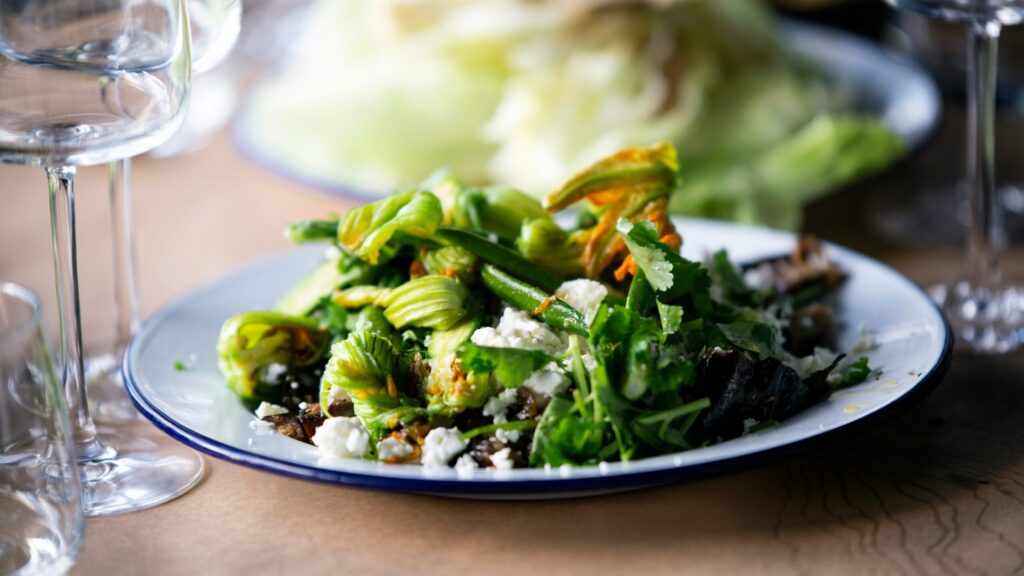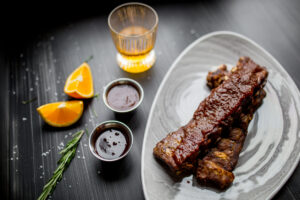As the New Year begins, many people are setting goals to improve their health and wellness, presenting a perfect opportunity for restaurants to align their marketing strategies with these renewed consumer interests. This is an opportunity to get new customers, since people are trying to change their ways. Even if there is plenty of indulgent food on your menu, you can still hop on this bandwagon by highlighting the healthy dishes you do have or the health benefits of ingredients in your food. Here’s a detailed guide on how to effectively market your restaurant’s healthy offerings and the health benefits of your ingredients using strategic design language and communication across various platforms.
Crafting the Right Message
Emphasize Nutritional Benefits: When marketing healthy dishes, focus on the benefits that resonate with your target audience. Use terms like “low-calorie,” “high-fiber,” “antioxidant-rich,” or “heart-healthy” to describe dishes in your menu descriptions. Clearly highlight key ingredients and their health benefits without making it sound clinical.
Identify Customer Goals: Depending on your target demographic your customers may have different goals. If your food is fast casual, maybe you serve highschool and college students, worried about fueling athletic pursuits and keeping their brains running at super speed. If your establishment is a fine dining restaurant, your demographic may have concerns around aging like food that benefits skin, memory retention, antioxidant and anti-inflammatory properties. Make sure to tailor your messaging around what your customers’ concerns are and what their New Year Resolutions might be.
Storytelling: Connect your dishes with stories about sourcing, preparation, and the inspiration behind them. For instance, if your salad uses organic local greens, share the story of the farm where the greens are grown, or explain how a particular dish is inspired by traditional recipes that naturally emphasize health and wellness.
Leveraging Different Platforms
Social Media:
- Instagram, TikTok and Facebook: These platforms are ideal for sharing high-resolution images of your dishes accompanied by brief descriptions that highlight their health benefits. Use hashtags such as #HealthyEating, #CleanEating, or #NewYearsResolution to increase visibility.
- Stories, Reels & TikTok Videos: Use Instagram Stories or Reels to create engaging behind-the-scenes content that shows the preparation of healthy dishes, or share customer testimonials praising the health benefits and taste of your offerings.
Email Marketing:
- Newsletter Content: Send out a monthly or weekly newsletter that includes a section highlighting healthy dishes, their nutritional content, and how they can help your customers meet their New Year’s health goals.
- Special Offers: Include promotions or discounts on healthy dishes to encourage customers to try them.
Your Website:
- Dedicated Health Section: Create a section on your website specifically for health-focused menu items. Include detailed descriptions, nutritional information, and appealing photographs.
- Blog Posts: Write blog posts about the health benefits of seasonal ingredients or share tips on maintaining a healthy diet that includes dining out. Link these posts to your menu.
- Loyalty Program: Promote your loyalty program for people that may want to shift to eating with your restaurant as a healthy choice.
In-Store:
Menu Updates
- Add Nutritional Descriptions: Clearly label dishes with health-related phrases. For example, instead of “Berry Smoothie,” write “Immune-Boosting Berry Smoothie with Vitamin C and Antioxidants.”
- Create a Healthy Highlight Section: Dedicate a part of your menu to “Healthy Picks” or “Wellness Bowls.” Feature dishes like “Protein-Packed Quinoa Salad” or “Gut-Friendly Kimchi Rice Bowl.”
- Icons for Quick Reference: Use icons for specific benefits (e.g., a leaf for plant-based, a heart for heart-healthy, or a muscle for protein-rich).
Signage
- Ingredient Spotlights: Create signs or chalkboards highlighting individual ingredients. For example, “Did you know? Turmeric in our curry boosts immunity and reduces inflammation!”; or “Superfood Salad: Packed with Vitamin A and Omega-3s, perfect for energy and heart health!”
- Seasonal Features: Showcase seasonal dishes with health benefits, like “Winter Wellness: Try our Kale and Lentil Soup, rich in iron and immune-boosting nutrients.
- Tabletop QR Codes: Add QR codes to tables or takeout bags that link to a webpage explaining the health benefits of your dishes.
By combining these targeted menu updates, in-store signage, and additional outreach, you’ll create a holistic experience that educates and excites your customers about choosing healthier options.
Design Language Tips:
When crafting design language around healthy food and New Year’s health resolutions, the goal is to create a visual and textual narrative that resonates with the aspirations and motivations of a health-conscious audience. Here are key elements to consider:
Visual Elements
- Color Palette: Utilize fresh, vibrant colors that evoke a sense of health and vitality. Greens, as the color of many vegetables, naturally convey healthiness. Complement these with bright fruit colors like citrus orange, berry red, or apple green to enhance the feel of freshness and energy.
- Typography: Choose clean, clear typefaces that suggest simplicity and clarity—mirroring the uncomplicated nature of healthy eating. Sans-serif fonts often work well by providing a modern, approachable look.
- Imagery: High-quality images of fresh produce, people engaging in healthy activities, or dishes prepared in a visually appealing manner are crucial. These images should be bright and lively, with a focus on the natural beauty and textures of the ingredients.
- Icons and Symbols: Use icons that are easily associated with health and wellness. For example, leaves, water droplets, hearts, or even exercise symbols can subtly suggest aspects of a healthy lifestyle that complements a nutritious diet.
- Layout and Composition: Keep designs clean and organized, with plenty of white space to avoid visual clutter. This mirrors the clean eating concept and makes the content easier to digest.
Textual Elements
- Voice and Tone: Maintain an inspirational and motivational tone. Encourage and affirm the reader’s decision to pursue a healthier lifestyle. Use active voice and positive language to keep the mood uplifting. Avoid guilt-based or negative messages.
- Key Messages: Highlight the benefits of your offerings, such as “boost your energy,” “nourish your body,” or “feel lighter and brighter.” Focus on the positive outcomes of eating healthy foods. Be careful about making direct health claims and make sure your copy is attorney approved. Cite reliable sources when available. We are not lawyers but we often use the phrasing “Research suggests” or “is said to have these benefits”.
- Content Type: Keep things short and sweet for easy reading, especially when listing benefits or ingredients. Some demographics want scientific detail but many just want the key health takeaways.
- Calls to Action: Make calls to action clear and direct, such as “Start your healthy journey with us,” “Order now to start your health journey,” These should motivate the audience to take the next step towards incorporating healthy choices into their daily routine.







